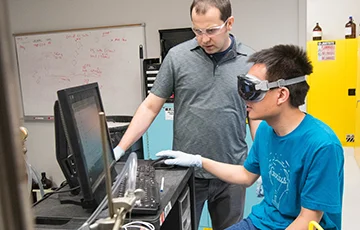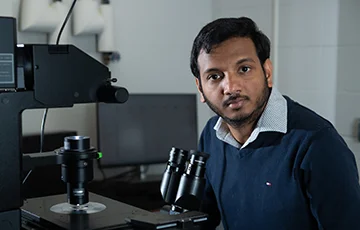Inorganic Chemistry & Energy-Related Research
These subfields of chemistry use molecular building blocks other than carbon to create new materials that harvest and store energy.
Energy Innovation and the Study of Metals, Minerals, and Organometallic Compounds
Inorganic chemistry is the study of the properties and behavior of compounds that do not contain carbon. This field encompasses the study of metals, minerals, and organometallic compounds, which are compounds with a metal or metalloid bonded directly to carbon. Inorganic chemists investigate how these materials can be modified, separated, and used.
Energy research encompasses the study and development of new materials, technologies, and methods for efficient energy conversion, storage, and sustainable energy production. It involves interdisciplinary collaboration between chemistry, engineering, physics, and biology to address challenges in areas like renewable energy, sustainable fuels, and energy storage.
Research highlights
- Development of new catalysts to turn renewable energy into clean fuels
- Usage of a special microscope technique (E-CLocK) that tracks how tiny particles change shape during chemical reactions
Research Projects
-

Professor Jonah Jurss
The Jurss Lab is an interdisciplinary research team that focuses on developing and understanding new earth-abundant catalysts for energy conversion chemistry and the selective functionalization of hydrocarbons. To address global energy concerns, we aim to store solar energy or renewable electricity in the chemical bonds of energy-rich fossil fuel alternatives, such as H2 and CH4, by coupling water oxidation to reductive half reactions (i.e. CO2 reduction). For hydrocarbon conversion, new catalysts are being developed to introduce functionality into organic molecules with unactivated C-H bonds to streamline organic synthesis.
The Jurss Lab -

Professor Vignesh Sundaresan
Nanoparticle (NP) morphology is a critical factor influencing the efficiency and selectivity of electrochemical reactions. However, conventional electrochemical techniques do not provide information about the dynamic morphological changes of NPs during these reactions. The Sundaresan Group uses dark-field-based electrochemical calcite-assisted localization and kinetics (E-CLocK) microscopy, a novel multiparameter super-resolution imaging technique enabling real-time, non-invasive tracking of qualitative and quantitative morphological changes at the single-nanoparticle level during electrochemical processes. In E-CLocK microscopy, a rotating calcite crystal is integrated into the infinity space of a dark-field microscope, generating a distinctive point spread function that can be analyzed to determine the anisotropy and orientation of NPs. Using gold NP electrodeposition as a model reaction, they quantitatively assess the morphological anisotropy of individual NPs during their growth. E-CLocK microscopy provides a high-throughput and reliable method for tracking morphological changes during electrochemical reactions, significantly advancing single-particle structure–activity studies.
Prof. Sundaresan's Group Website
